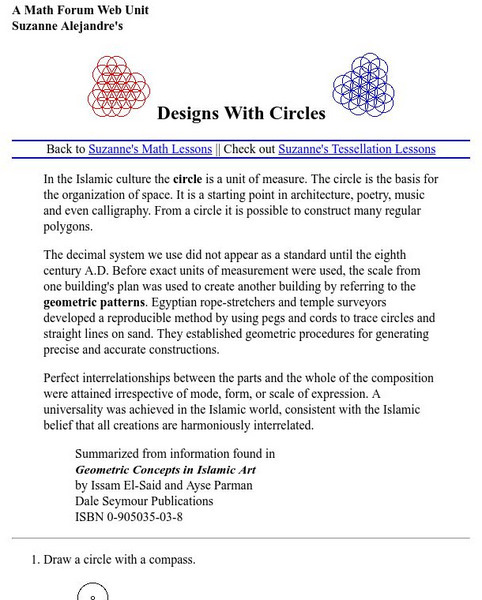Hi, what do you want to do?
Metropolitan Museum of Art
Islamic Art and Geometric Design
After an overview of Islamic traditions and art, young artists create their own geometric shapes and patterns using only a straightedge and a compass.
National Gallery of Art
Islamic Art and Culture
Provided by the National Gallery of Art in Washington, this resource for teachers examines Islamic art, including calligraphy, arabesques, and geometric designs. A recounting of the spread of the faith and the tumultuous political...
Curated OER
Middle Eastern Geometric Art
Students examine how Islamic artists represented their beliefs in logic and order through the geometric patterns in their art works. They analyze star patterns in Middle Eastern designs, and create geometric patterns using geometric shapes.
Curated OER
Middle-East Reflections
Practice symmetry and patterns with this Mid-Eastern art project. Your class will create beautiful, reflective mosaics that will brighten up the classroom! A list of necessary materials is included.
Curated OER
Islamic Art/ Eraser Prints
Students are shown examples of mosaics found on mosques. We discuss background information on Islam and relate it to social studies units. This is also a great unit to integrate math skills.
Curated OER
Qur'an: Sacred Scripture of Islam
Pupils discover the strong emphasis Islam puts on education. Using the Internet, they identify advancements in ethics, math and astronomy. They explain the importance of madrasahs, or traditional places of learning in Islam, and...
Curated OER
Scholarship and Learning in Islam
Students explain what a madrasah represents in Islam. Using the Muslim world as an example, they identify and describe two or more centers of learning. They explain the contributions that Muslims have made to science and math and...
Curated OER
The Mathematician And The Archaeologist
Students decorate clay pots and destroy them in order to learn the techniques of modern-day archaeologists and practice mathematical measurements. This is an exciting lesson suitable for Social Studies, Math, Science, or Art classroom.
Curated OER
Teaching Reading Comprehension through Social Studies Readings
Examine how immigrants have changed the environment of the United States. Individually, middle schoolers will take a pre- and post-test to assess their reading comprehension. In groups, they compare and contrast the religions of...
Curated OER
Doorways/Printmaking
Pupils are introduced to the techniques used in printmaking along with the relief method and tessellation relationships to art. In groups, they examine a variety of architecture used throughout the Islamic culture. To end the lesson,...
Curated OER
The Middle-East; Water and Life
Tenth graders examine the physical and cultural impressions made by water in the Middle East, as well as their own lives, through exercises in reading, writing, geography and art. They explore how water as an economic good drives...
Curated OER
Discovering Math: Concepts in Algebra
Students learn that speed is a function of time and distance, a quadratic equation can be used to figure out the path of fireworks, a photographer can use Algebra to figure out how many rolls he can afford if he needs twice as much of...
Curated OER
Grade 5: Testing for Tessellations
Fifth graders use formal geometric language to describe polygons (and other shapes) that will tessellate the plane and those that will not. Students make generalizations about the characteristics of a polygon (or other shape) that will...
Curated OER
History of World Religions
First graders listen to a variety of Noah's Ark, based on the story in the Old Testament. They hear another "flood story" for comparison.
Curated OER
Magnificent Mandalas
Students examine the principle of radial symmetry and apply it to an original mandala design. They draw a design using organic and geometric shapes, repeating the design symmetrically around the paper.
Curated OER
Tantalizing Tessellations - Lesson I
Students complete a chart (KWL) as a pre-assessment, study the history of tessellations (tilings), investigate the properties of tessellations, and make and evaluate photographs of "found tessellations" for a PowerPoint/HyperStudio...
TES Global
Tes: Maths and Islamic Art & Design
[Free Registration/Login Required] This is a collection of design and shape templates from the Maths and Islamic Art & Design sections of the Victoria and Albert Museum. It provides the following templates: Islamic circular grid,...
National Council of Teachers of Mathematics
The Math Forum: Suzanne Alejandre's Designs With Circles
In the Islamic culture, circles are considered to be a unit of measurement and the basis for the organization of space. This is illustrated at this site by a series of exercises.






















